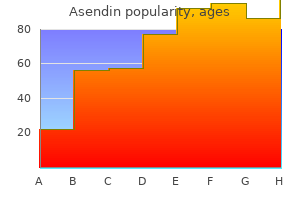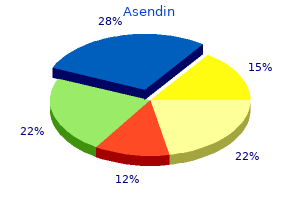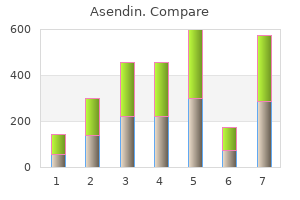"Buy asendin 50 mg with mastercard, anxiety reduction techniques."
By: Kate Leslie, MB, BS, MD
- Staff Specialist, Head of Anesthesia Research, Royal Melbourne Hospital
- Professor, Department of Anesthesiology, Monash University, Melbourne, Australia
https://research.monash.edu/en/persons/kate-leslie
It consists of a single layer of flattened mood disorder in adults discount asendin 50mg fast delivery, polygonal cells that in people bear microvilli on their free surfaces depression test in urdu discount asendin 50 mg with visa. The periderm protects the epidermis and will serve in some change capability between the fetus and amniotic fluid anxiety jacket for dogs reviews order asendin 50mg on line. Bleb-like projections type on the surfaces of the periderm cells clinical depression symptoms yahoo 50 mg asendin free shipping, reaching most growth firstly of the sixth week and thereafter lowering in measurement. At the identical time blebbing happens, the cell membrane exhibits alterations just like people who happen within the keratinization of adult epidermal cells. The basal layer is the only portion of epidermis correct within the 1- and a couple of-month-old fetus. During the primary two months, peridermal and epidermal cells are filled with glycogen and have few organelles. In the second month, bundles of filaments develop within the epidermal cells, along with desmosomes and hemidesmosomes. More in depth intermediate filaments, presumed to be keratin, unfold throughout the cytoplasm. Basal cells are the primary to lose glycogen and attain adult morphology, and as they proliferate, additional layers are added between the periderm and the basal layer. The first intermediate cells appear at 9 to 10 weeks and the layer is absolutely developed by 11 weeks. The cytoplasm of the intermediate cells is filled with glycogen, however desmosomes and filaments also are distinguished. As the number of intracellular keratin filaments increases, the quantity of glycogen diminishes. The outermost intermediate cells accumulate laminar granules at their upper borders, then differentiate into cells with cornified cell membranes, bundles of keratin filaments, and small amounts of glycogen of their cytoplasm. Once the stratum granulosum has formed, true cornified cells appear and a thin stratum corneum becomes evident by the end of 6 months. Thus, at the end of the second trimester, all of the layers of the epidermis are established. Melanocytes migrate into the epidermis from the neural crest in the course of the second month and synthesize melanin within the forth month. The first floor ridges are formed on the palmar and plantar surfaces of the tips of the digits at in regards to the thirteenth week. The dermis soon is nicely outlined and organized into papillary and reticular layers. Initially, the dermoepidermal junction is easy, however dermal ridges soon appear and may be identified by the third to fourth month of gestation. Hairs arise from solid cords of epidermis (hair buds) that develop into the dermis at an angle. Each hair bud has an outer layer of columnar cells and an inside core of polygonal cells. The deepest a part of the hair bud swells to type the hair bulb, which comes to sit, cuplike, over a small mound of mesenchyme that forms the papilla of the hair. The primitive dermal connective tissue along the length of the hair bud condenses to type the connective tissue sheath of the hair follicle. Cells at the periphery of the hair bud give rise to the epidermal portions of the basis sheath: the inside cell mass forms the substance of the hair. Solid buds of cells develop into the surrounding mesenchyme, branching into a number of flask-shaped alveoli. The lining cells, derived from stratum germinativum, proliferate, pushing older cells towards the center where they elaborate fat, degenerate, and type sebum. A mobile bulge on the basis sheath, under the origin of the sebaceous glands, supplies for the attachment of the arrectores pilorum muscle tissue, which arise independently from mesenchyme. As these elongate, the deeper portions turn into coiled to type the secretory units of the glands. Myoepithelial cells associated with the secretory portions of the glands arise locally from the identical epidermal bud. Some sweat glands (apocrine sweat glands) develop from superficial epidermal swellings on hair follicles; their ducts empty into the uppermost a part of the follicle. Summary the outer, keratin layer of the epidermis is extremely impermeable to water and rather inert chemically. It is that this portion of the epidermis that acts as the primary barrier to mechanical injury, desiccation, and invasion by bacteria.
Rutine (Rutin). Asendin.
- What other names is Rutin known by?
- Blood vessel disease, varicose veins, prevention of mouth ulcers associated with cancer treatments, bleeding, and hemorrhoids.
- What is Rutin?
- Are there safety concerns?
- How does Rutin work?
- Osteoarthritis when taken in combination with trypsin and bromelain.
- Dosing considerations for Rutin.
Source: http://www.rxlist.com/script/main/art.asp?articlekey=96293

Adjunctive measures mood disorder icd 9 code asendin 50 mg without prescription, corresponding to head-ofbed elevation depression chemical imbalance discount asendin 50 mg amex, corticosteroids anxiety zone ebola safe asendin 50 mg, anti-reflux medications depression symptoms francais buy asendin 50mg with amex, and humidification should be strongly thought of. Small, nonprogressing hematomas with intact mucosal protection are prone to resolve spontaneously with out vital sequelae. Adjunctive therapies, corresponding to steroids, anti-reflux medication, humidification, and head-of-mattress elevation are useful. Large or expanding hematomas might lead to airway obstruction and necessitate placement of a tracheotomy. Recurrent laryngeal nerve harm after blunt laryngeal trauma could also be because of both stretching of the nerve or nerve compression near the cricoarytenoid joint. Displaced thyroid and cricoid cartilage fractures should be reduced and fixed to stabilize the laryngeal framework (Figure 8. If the displaced cartilage fracture occurs at the side of an endolaryngeal, soft tissue harm, the cartilage reduction and fixation should be performed prior to endolaryngeal soft tissue restore. This ensures that a correct scaffold is obtained earlier than redraping the laryngeal mucosa. If no soft tissue harm accompanies the cartilage fracture, the cartilage could also be fixed externally with out entering the larynx. Thyroid fractures fixed with wire or suture are inclined to heal by fibrous-not cartilaginous-union, and infrequently fail to maintain correct anatomic reduction. In specific, wire fixation poorly maintains the proper anatomic position of the thyroid laminae after fixation, allowing midline fractures to heal in an inappropriately flattened position. Most patients with laryngotracheal separation current with vital respiratory misery and require a tracheotomy. Performance of the tracheotomy can be extraordinarily troublesome, nevertheless, because of the altered anatomy that results from this harm. After laryngotracheal separation, the larynx usually pulls upward and the trachea retracts into a position behind the sternum, necessitating a low tracheotomy incision. Pneumothorax commonly accompanies a laryngotracheal separation and have to be promptly recognized and handled. Following applicable trauma analysis and radiologic research, the patient ought to return to the working room for direct laryngoscopy, esophagoscopy, and tracheal restore. The severed ends of the laryngotracheal advanced should be freshened and then closed with nonabsorbable sutures with the knots positioned extraluminally. Suprahyoid or infrahyoid launch maneuvers could also be required so as to permit for a pressure-free anastamosis. Most patients with laryngotracheal separation may even have bilateral vocal cord paralysis because of stretching or tearing of the recurrent laryngeal nerves. If the severed ends of the nerves can be located, they need to be repaired primarily. When evaluating the soundness of the airway, it is very important keep in mind that initially delicate signs and signs might accompany a really extreme laryngeal harm. Further, laryngeal accidents might evolve, progress, and worsen in a relatively short time frame. Therefore, fastidiously performed flexible fiberoptic laryngoscopy is a crucial tool within the initial analysis of the injured airway. Intubation ought to ideally be avoided, because the endotracheal tube might additional traumatize the endolarynx, destabilize laryngeal fractures, or lead to an acute airway compromise. Airway Stents Stents are often utilized in laryngeal accidents where the anterior commissure is significantly disrupted. In these circumstances, the stent capabilities to maintain the proper configuration of the commissure and to prevent anterior glottic webs. They are additionally occasionally used when massive, endolaryngeal mucosal accidents happen. In these circumstances, the stent helps to prevent mucosal adhesions and subsequent laryngeal stenosis. If full mucosal integrity is reestablished and the laryngeal fractures are properly reduced, stents are best avoided because of their potential complications-infection, strain necrosis, and granulation tissue formation. While the best type of stent may be very controversial, solid silastic stents are usually most well-liked.

An ectoderm-coated oral half from the mandibular arches types the physique of the tongue: an endodermal pharyngeal half from the second branchial arch provides rise to depression definition by apa asendin 50mg with amex the remainder of the tongue depression hyperbole and a half asendin 50mg without prescription. The junction between ectoderm and endoderm is simply anterior to bipolar depression lifting asendin 50 mg overnight delivery the sulcus terminalis depression physical pain purchase asendin 50 mg on-line. Thus, fungiform and filiform papillae are ectodermal in origin, and the circumvallate papillae are endodermal in origin. At first the tongue is roofed by cuboidal epithelium, which later becomes stratified squamous. A thickened epithelial ring surrounds each circumvallate papilla, grows into the mesenchyme, and splits to type a trench around each papilla. Taste buds develop on the dome of every circumvallate papilla but are replaced by definitive buds along the lateral sides of the papilla. Taste buds first seem as local thickenings of epithelium in which basal cells elongate, grow towards the surface, and provides rise to supporting and style cells. All begin from the epithelial surface as buds that grow and branch, treelike, to type a system of strong ducts. Terminal twigs, which eventually type intercalated ducts, spherical out at their ends to type secretory tubules and acini. The sublingual gland differs slightly in that a number of buds type from the oral epithelium and every stays a discrete gland. The parotid seems first, adopted by the submandibular, sublingual, and, later nonetheless, minor salivary glands. Mesenchyme surrounding the epithelial primordia offers the capsule and septae of the salivary glands. Teeth have a dual origin: enamel arises from ectoderm; dentin, pulp, and cementum arise from mesoderm. Tooth improvement begins with the appearance of the dental lamina, a plate of epithelium on which knoblike swellings (enamel organs) seem at intervals. The enamel organs grow into the mesenchyme to type inverted, cuplike constructions invaginated at the bases by dental papillae. The latter are condensations of mesenchyme that give rise to the dentin and pulp of teeth. The enamel organ types a double-walled sac, of which the outer and inner partitions differentiate into outer and inner enamel layers, respectively. Cells of the inner layer become ameloblasts and produce enamel prisms, starting at the interface with the dental papillae. Mesenchymal cells of the papillae subsequent to the inner dental layer enlarge and differentiate into odontoblasts. Thereafter, each enamel and dentin are laid down, starting at the apex and progressing towards the basis. As the enamel and dentin layers thicken, the odontoblasts and ameloblasts steadily transfer away from each other. Ameloblasts migrate peripherally, remaining at the outer surface of the enamel, and eventually are lost from the tooth at eruption. This cuticle may persist for a substantial time after teeth erupt and the ameloblasts are lost. As they retreat, the odontoblasts path fantastic cytoplasmic processes that extend via the dentin to the dentinoenamel junction. The entrapped processes type the dentinal fibers contained in fantastic dentinal tubules. Mesenchyme around the creating enamel organ differentiates into the unfastened connective tissue of the dentinal sac. Near the basis, the inner cells of the sac become cementoblasts and canopy the dentin with cementum. Cells at the exterior of the sac differentiate to produce the alveolar bone that surrounds each tooth. Before the tooth erupts, a small crater seems within the gingival epithelium and connective tissue, immediately above the crown. The crater, which expands to accommodate the tooth as it emerges, develops from focal strain necrosis because the tooth grows upward, or by the use of lytic activity of enzymes produced by the dental epithelium, or each. Alimentary Canal the esophagus, stomach, small intestine, and colon initially include an endodermal tube surrounded by a layer of splanchnic mesoderm. The endoderm provides rise to the lining epithelium and all related glands of the digestive tube; mesoderm differentiates into the supporting layers of the gastrointestinal tube.

Entrapment of the long head of the biceps tendon: the hourglass biceps-a reason for pain and locking of the shoulder depression zodiac cheap asendin 50 mg amex. The stabilization sling for the long head of the biceps tendon within the rotator cuff interval refractory depression definition purchase asendin 50mg fast delivery. Dynamic ultrasound evaluation within the diagnosis of intra-articular entrapment of the biceps tendon (hourglass biceps): a preliminary investigation depression definition history cheap asendin 50mg. Tomonobu H vapor pressure depression definition 50 mg asendin free shipping, Masaaki K, Kihumi S, Kenji O, Sunao F, Akihiko K, Mituhiro A, Masamichi U, Seiichi I. The incidence of glenohumeral joint abnormalities concomitant to rotator cuff tears. The mechanism of creation of superior labrum, anterior, and posterior lesions in a dynamic biomechanical model of the shoulder: the function of inferior subluxation. Diagnostic accuracy of history and bodily examination of superior labrum anterior-posterior lesions. A potential evaluation of a brand new bodily examination in predicting glenoid labral tears. The lively compression test: a brand new and effective test for diagnosing labral tears and acromioclavicular joint abnormalities. Diagnostic worth of bodily checks for isolated continual acromioclavicular lesions. Biceps load test: a scientific test for superior labrum anterior and posterior lesions in shoulders with recurrent anterior dislocations. Glenohumeral muscle activation during provocative checks designed to diagnose superior labrum anterior-posterior lesions. Impingement of the deep floor of the supraspinatus tendon on the posterosuperior glenoid rim: an arthroscopic research. Arthroscopy of the shoulder within the management of partial tears of the rotator cuff: a preliminary report. Arthroscopic findings within the overhand throwing athlete: proof for posterior internal impingement of the rotator cuff. Failure of the biceps superior labral complex: a cadaveric biomechanical investigation evaluating the late cocking and early deceleration positions of throwing. The anatomical basis of the resisted supination exterior rotation test for superior labral anterior to posterior lesions. Physical examination and magnetic resonance imaging within the diagnosis of superior labrum anteriorposterior lesions of the shoulder: a sensitivity analysis. The function of negative intraarticular stress and the long head of biceps tendon on passive stability of the glenohumeral joint. Since roughly one-fourth of the humeral head articular floor stays in contact with the glenoid all through the vary of shoulder movement [1], instability may end up when static and/or dynamic stabilizers are disrupted. Static stabilizers embrace bony articular congruency, the glenohumeral ligaments, the glenoid labrum, the rotator interval, and the negative intraarticular stress whereas dynamic stabilizers embrace the rotator cuff and periscapular musculature. As a result of the numerous buildings concerned with the maintenance of glenohumeral stability, bodily examination of the affected person with instability could be particularly difficult. However, an effective examination most frequently reveals a characteristic sample of indicators and signs that usually lead the clinician in direction of the right diagnosis. The steadiness between mobility and stability of the glenohumeral joint is achieved by way of the coordinated, complex interactions between a number of static and dynamic stabilizers that perform to middle the humeral head inside the glenoid fossa all through the full vary of shoulder movement. Static constraints embrace articular congruency, glenoid model, the coracoacromial arch, the glenoid labrum, capsuloligamentous buildings, the rotator interval, and the inherent negative intraarticular stress. Dynamic constraints embrace the rotator cuff and periscapular musculature which both contribute to the properly-described concavity compression mechanism. The inferior aspect of the glenoid is more round and its symmetry is commonly used to measure the amount of acute or attritional bone loss in circumstances of recurrent instability. Approximately onefourth of the humeral head makes contact with the glenoid at any point all through the whole vary of shoulder movement, thus highlighting the significance of strong soft-tissue stabilizers that serve to maintain the constant steadiness between movement and stability. Geometrically, the glenohumeral ratio (maximum glenoid diameter divided by the maximum diameter of the humeral head) is roughly 0. Biomechanically, glenohumeral stability is decided by the steadiness stability angle (maximum angle of the axial pressure vector applied by the humeral head to the glenoid middle line) and the effective glenoid arc (radius of curvature of the glenoid able to help the joint reaction pressure produced by the humeral head), a parameter which incorporates the increased depth produced by an intact labrum. Note that solely roughly 25 % of the humeral head articular cartilage makes contact with the glenoid all through the whole arc of movement.
50 mg asendin fast delivery. Nursing Care Plan Tutorial | How to Complete a Care Plan in Nursing School.
References:
- https://wp.nyu.edu/biochemistry1_002/wp-content/uploads/sites/274/2014/10/Biochemistry-1-2014-Lecture-Notes-Chapter-6.pdf
- http://www.med.umich.edu/asp/pdf/adult_guidelines/COVID-19-treatment.pdf
- https://ldhm.adsa.org/Large_Dairy_Herd_Management_Third_Edition_(Preface_Only).pdf
- https://invivoscribe.com/uploads/products/instructionsForUse/280397.pdf
- https://www.aamc.org/system/files/d/1/271020-behavioralandsocialsciencefoundationsforfuturephysicians.pdf

